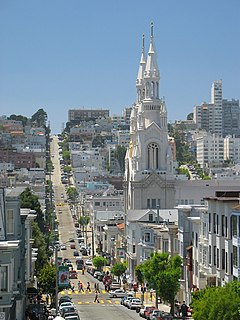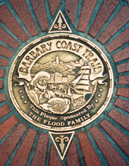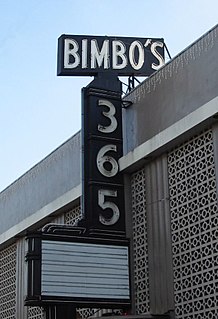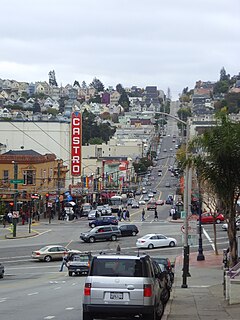
North Beach is a neighborhood in the northeast of San Francisco adjacent to Chinatown, the Financial District, and Russian Hill. The neighborhood is San Francisco's "Little Italy" and has historically been home to a large Italian American population. It still has many Italian restaurants, though many other ethnic groups currently live in the neighborhood. It was also the historic center of the beatnik subculture and has become one of San Francisco's main nightlife districts as well as a residential neighborhood populated by a mix of young urban professionals, families, and Chinese immigrants.

A taxi dancer is a paid dance partner in a partner dance. Taxi dancers are hired to dance with their customers on a dance-by-dance basis. When taxi dancing first appeared in taxi-dance halls during the early 20th century in the United States, male patrons would typically buy dance tickets for a small sum each. When a patron presented a ticket to a chosen taxi dancer, she would dance with him for the length of a single song. The taxi dancers would earn a commission on every dance ticket earned. Though taxi dancing has for the most part disappeared in the United States, it is still practiced in some other countries.

Pacific Heights is a neighborhood of San Francisco, California, which is known for the notable people who reside in the area. It has panoramic views of the Golden Gate Bridge, San Francisco Bay, the Palace of Fine Arts, Alcatraz, and the Presidio.
The Texas Tommy is a vigorous social dance for couples that originated in San Francisco in the early twentieth century.

Kearny Street in San Francisco, California runs north from Market Street to The Embarcadero. Toward its south end, it separates the Financial District from the Union Square and Chinatown districts. Further north, it passes over Telegraph Hill, interrupted by a gap near Coit Tower.

The Great American Music Hall is a concert hall in San Francisco, California. It is located on O'Farrell Street in the Tenderloin neighborhood on the same block as the Mitchell Brothers O'Farrell Theatre. It is known for its decorative balconies, columns, and frescoes and for its history of unique entertainment, which has included burlesque dancing as well as jazz, folk music, and rock and roll concerts. The capacity of the hall is 470 people.
The 49-Mile Scenic Drive is a designated scenic road tour highlighting much of San Francisco, California. It was created in 1938 by the San Francisco Down Town Association to showcase the city's major attractions and natural beauty during the 1939 Golden Gate International Exposition.
Isadore Gomez was a Portuguese immigrant, chef and restaurateur in the North Beach neighborhood of San Francisco, California. In 1943, he was recognized by LIFE magazine as one of San Francisco's most colorful characters. His birthday was celebrated on February 9.
Pal Joey is a 1957 American Technicolor musical film, loosely adapted from the musical play of the same name, and starring Rita Hayworth, Frank Sinatra, and Kim Novak. Jo Ann Greer sang for Hayworth, as she had done previously in Affair in Trinidad and Miss Sadie Thompson. Kim Novak's singing voice was dubbed by Trudy Stevens. George Sidney directed, with the choreography managed by Hermes Pan. Nelson Riddle handled the musical arrangements for the Rodgers and Hart standards "The Lady is a Tramp", "I Didn't Know What Time It Was," "I Could Write a Book" and "There's A Small Hotel."

The Saloon, located at 1232 Grant Avenue in North Beach, is currently the oldest saloon of San Francisco and for decades has offered dancing and live music.
A taxi dance hall is a type of dance hall where dancers, usually young women, called taxi dancers are paid to dance with usually male patrons. The owners of a taxi dance hall provide music and a dance floor for their patrons and taxi dancers. In the United States during the 1920s and 1930s, when taxi dancing was at its peak, patrons of taxi dance halls would typically buy dance tickets for ten cents each. When they presented a ticket to a taxi dancer, she would dance with them for the length of a single song. Taxi dancers earned a commission on every dance ticket that they collected. The ticket-a-dance system was the centerpiece of the taxi dance halls. Taxi dance halls are vividly represented on the ouverture of Henry Miller novel Sexus, where the narrator falls in love with a taxi dancer after meeting her on a Thursday night, circa 1928.

The Barbary Coast Trail is a walking tour connecting 20 historic sites and local history museums in San Francisco, California. Approximately 180 bronze medallions and arrows embedded in the sidewalk mark the 3.8-mile (6.1 km) trail.
The San Francisco Brewing Company was the second-oldest bar in San Francisco, trailing the famous "The Saloon", opened 1861, by forty-six years. It was however, San Francisco's oldest micro-brewery, and one of the first four brew pubs in the United States. It was not always known as the Brewing Company, as only in recent decades did it take the moniker. It was located on the edge of what was once known as the Barbary Coast, at the intersection of Columbus and Pacific Avenues. The pub originally opened its doors in 1907 as the Andromeda Saloon, where "angling executives, sharp-talking politicians and homesick sailors all rubbed elbows while brazen prostitutes flaunted coquettish charms at the brass rail of the ornate bar."

The Sporting District in the U.S. city of San Antonio, Texas was a red-light district in the late 19th and early 20th centuries. It was established by the city council to manage prostitution in the city. For a time it was one of the nation's largest vice districts with venues ranging from brothels to gambling halls. The area was officially shut down in 1941 resulting from the mobilization for World War II.

Bert Kelly was an American musician, who pioneered jazz as a banjoist, bandleader, educator, promoter, night club owner, and night club operator. After professional stints in Seattle and San Francisco, Kelly moved to Chicago in 1914 where he flourished a banjoist, bandleader, and promoter. In 1915 — before the U.S. prohibition — he founded and operated a Chicago speakeasy called "Bert Kelly's Stables," where patrons were introduced to early jazz.

Bimbo's 365 Club, also known as Bimbo's 365, is an entertainment club located at 1025 Columbus Avenue in San Francisco. It specializes in live rock and jazz shows. The location is one of San Francisco's oldest nightclub sites, and has operated under two names with a series of owners. The building started as Bal Tabarin in 1931, the same year that the 365 Club started at 365 Market Street. The two locations under separate ownership consolidated in 1951 to one location owned by Agostino "Bimbo" Giuntoli.

The Castro District, commonly referenced as The Castro, is a neighborhood in Eureka Valley in San Francisco. The Castro was one of the first gay neighborhoods in the United States. Having transformed from a working-class neighborhood through the 1960s and 1970s, the Castro remains one of the most prominent symbols of lesbian, gay, bisexual, and transgender (LGBT) activism and events in the world.

Law of the Barbary Coast is a 1949 American historical crime film directed by Lew Landers and starring Gloria Henry, Stephen Dunne and Adele Jergens.




















